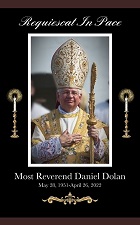A CATHOLIC DICTIONARY:
CONCORDAT (Lat. concordata, things agreed upon). A treaty between the Holy See and a secular State touching the conservation and promotion of the interests of religion in that State.
It were to be wished that Christendom did not require concordats, for a treaty between two powers implies some felt divergency of sentiment and principle, which, having already resulted in opposition and contention more or less serious, dictates to the contracting parties the necessity of coming to an understanding as to the limits beyond which neither will give way to the other. Such divergency of sentiment only arises, speaking generally, when the secular State aims at excluding the Church from its rightful share of control over human affairs - an aim which familiar experience shows to be eminently pernicious and disastrous.
When Ethelberts or St. Louises rule in temporals, we do not hear of concordats with the Holy See, for such rulers desire to see religion more, not less, in the ascendant among their subjects. Nevertheless, considering the actual condition of things in Europe and America, it is generally a subject of congratulation when the Pope concludes a fresh concordat; we know that, at any rate for a time, religion and its ministers will be treated with some justice and moderation in the treaty making State; that if the Church has been robbed there in time past, some modicum of a yearly grant will now be given by way of restitution; and that the churches and convents will be made over to her - at any rate till the next revolution.
Among the more celebrated concordats of former times are the following:
1. That of Worms in 1122, between Calixtus II and the Emperor Henry V, by which the abusive right of appointing bishops and abbots "by ring and crosier," long usurped by the emperors, was resigned, and only the investiture by the sceptre, in token of the grant of their temporalities, retained. On the lines of this concordat the question of investiture was settled throughout Europe in such a way as to leave intact in theory the universal pastorate of the successors of Peter, however seriously it may have been here and there compromised in practice.
2. That of Frankfort or Vienna (1446-8), called the Concordat with the German Nation, by which the Popes Eugenius IV and Nicholas V, employing Nicholas of Cusa [BASLE, COUNCIL] and AEneas Sylvius as negotiators, agreed with the emperor Frederic III to divide in a particular manner the patronage of ecclesiastical dignities in Germany, and as to the payment of firstfruits and other matters.
3. That of 1515, between Leo X and Francis I, by which the latter agreed to abolish the pragmatic sanction of Charles VII (limiting appeals to Rome, and pretending to set a general council above the Pope), and the former resigned to the crown of France the nomination to vacant bishoprics and abbeys, with the proviso that the persons named should be acceptable to the Holy See.
In later times, the concordat of 1801, between Pius VII and the first Napoleon, restoring to the French nation the public practice of the religion of their fathers, which the detestable wickedness of the revolutionists had proscribed since 1790, is a treaty of primary importance. Under its terms the Holy See agreed to a new demarcation of the boundaries of French dioceses, reducing their number from over 100 to about 80, and declared (art. 13) that neither the reigning Pope nor his successors would molest the purchasers or grantees in the peaceable possession of Church lands alienated up to that date. On the other hand the French Government agreed to the free and public exercise of the "Catholic, Apostolic, and Roman" religion in France; consented (art. 4, 5) to the canonical institution by the Pope, under the ancient discipline, of the bishops whom the Government should nominate; promised (art. 14) a suitable annual grant for the support of the French bishops and clergy; and undertook to facilitate (art. 15) fresh endowments on the part of any French Catholics desiring to make them. These were the principal articles of the concordat signed by the Papal envoys on behalf of the Holy See. The Government of Napoleon soon afterwards added to the concordat a number of clauses called "organic articles," the tenor of which was of course highly Erastian, and by which it has been often maintained by the French and other publicists that the French clergy are bound. This, however, since the Holy See never ratified the "organic articles," is not the case.
In an interesting supplementary article in vol. xxvi of Wetzer and Welte's Dictionary on Concordats, the text of several modern conventions of this kind (with Russia, 1 847; with the republic of Costa Rica, 1852; with Austria, 1855) is given in full.
(Ferraris, Concordata; Soglia, i. 4, De jure novissimo; Mohler's "Kirchengeschichte.'') (1)
THE CATHOLIC ENCYCLOPEDIA:
Concordat. - Definition. - Canonists and publicists do not agree about the nature of a concordat and, consequently, vary much in the definition they give. The various theories will be explained later, but for the sake of orderly discussion at least a nominal definition will be premised. In general, a concordat means an agreement, or union of wills, on some matter. But as soon as we attempt to define this general notion more clearly a difficulty arises. Agreement of wills may be had in many ways: in friendship, in regard to privileges, in a bilateral contract, etc. Prescinding for the present from the exact nature of a concordat, and without giving an exact definition, we may say that a concordat is a law, ecclesiastical and civil, made for a certain country in regard to matters which in some way concern both Church and State, a law, moreover, possessing the force of a treaty entered into by both the ecclesiastical and civil power and to a certain extent binding upon both. The full meaning of the terms employed will be explained below.
Purpose. - The purpose of a concordat is to terminate, or to avert, dissension between the Church and the civil powers. This is evident from history. During the first three centuries, when the civil authority was bent upon the total ruin and destruction of the Church, concordats were out of the question. After the era of persecution was over, and, with the exception of some temporary usurpations and outrages, the Christian Emperors of Rome generally recognized and defended the rights of the Church, concordats were unnecessary. This state of affairs continued until the end of the eleventh century, when there arose the strife about investitures which was settled in 1122 by the Concordat of Worms, or Pactum Callixtinum, between Callistus II (q. v.) and Henry V. This may be called the first concordat, unless the agreement of London (1107) is reckoned, as it may be, among the number of concordats. The contest between Boniface VIII and Philip the Fair, at the end of the thirteenth century, opened the way for still further disagreements between the Church, which strove to preserve its rights inviolate, and those civil powers which sought to usurp them. These disagreements gave rise to various concordats. Before the eighteenth century there were six (or seven if the London agreement of 1107 be counted); during the eighteenth century there were fifteen, and in the nineteenth century a much larger number.
With regard to the necessity of concordats two extreme opinions are to be avoided. Concordats are not absolutely necessary; neither are they harmful to the Church or civil society. Assuredly it were to be desired that the Church should never need concordats, and should always find in civil rulers devoted children, or at least such as would use all diligence in caring for the spiritual welfare of their Catholic subjects, and would religiously respect their rights. But, unfortunately, the contrary too often occurs. Hence the Church, to avoid a greater evil, has often had to promise to forego this or that natural right of her own in order to secure from the State a promise to refrain from further encroachment upon ecclesiastical rights.
Matter or Object of a Concordat. - The matter, or the objects, treated of in a concordat may be spiritual, mixed, or temporal.
Spiritual matters are those that belong purely to the spiritual order, or are connected with it: for example, matters pertaining to the liturgy. Thus, in some concordats there has been question of inserting the name of the emperor in the Canon (q. v.) and of singing after the Divine Office the formula: "Domine, salvam fac rempublicam", or "Domine, salvos fac consules", or "Domine, salvos fac praesides eius" (cf. art. 8, of the Concordat of 1801; arts. 23, 24 of the Concordat with Costa Rica and Guatemala, 1853; arts. 15, with Haiti, 1860; art. 21, with Ecuador, 1862; arts. 22, 23, with Nicaragua and San Salvador, 1863). In like manner there is frequent mention of nominating bishops, of the establishment and bestowal of parishes, or of prescribing special regulations for the promotion of clerics to Holy orders or to ecclesiastical dignities, so as to prevent, for example, the number of clerics from becoming too large (cf. art. 5, Concordat with Spain, 1737; C. iv, Concordat with Sicily, 1741), and so on.
Temporal matters are such as of their own nature do not belong to the spiritual order. In some concordats the Church has allowed rulers to impose taxes not only on the private possessions of clerics, but also on ecclesiastical property; so the Roman Pontiff has at times given up his claims on account of certain ecclesiastical properties damaged in the course of civil or religious turmoil. Examples of each of these occur in the Concordat with Columbia, in 1887. It is to be noted that, when the pope absolutely surrenders temporal possessions of the Church, as in art. 29 of this concordat, such possessions no longer remain under the ownership or jurisdiction of the Church or subject to it. When, however, he merely permits such property to be taxed (as in art. 6 of the Colombian Concordat, art. 18 or art. 19 of that with Costa Rica, in 1853) then the property remains in the ownership of the Church, which does not acknowledge in the State any inherent right to impose taxes of this kind, but rather implies the contrary by the very concession. (2)
References:
(1) A CATHOLIC DICTIONARY
CONTAINING SOME ACCOUNT OF THE
DOCTRINE, DISCIPLINE, RITES, CEREMONIES,
COUNCILS, AND RELIGIOUS ORDERS OF
THE CATHOLIC CHURCH
BY WILLIAM E. ADDIS
SECULAR PRIEST : SOMETIME FELLOW OP THE ROYAL UNIVERSITY OF IRELAND
AND THOMAS ARNOLD, M.A.
FELLOW OF THE SAME UNIVERSITY
SIXTH EDITION, WITH ADDITIONS.
NEW YORK
THE CATHOLIC PUBLICATION SOCIETY CO.
9 BARCLAY STREET
1887
NlHIL OBSTAT: EDUARDUS S. KEOGH, CONG. ORAT., CENSOR DEPUTATUS
IMPRIMATUR: HENRICUS EDUARDUS, CARD. ARCHIEP. WESTMONAST. Die 18 Dec., 1883.
IMPRIMATUR: JOHN CARD. McCLOSKEY, ARCHBISHOP OF NEW YORK. Feb. 14, 1884.
Copyright, LAWRENCE KEHOE, 1884.
Copyright, LAWRENCE KEHOE, 1887.
JURISDICTION
p. 204-205
(2) THE CATHOLIC ENCYCLOPEDIA
EDITED BY
CHARLES G. HERBERMANN, Ph.D., LL.D.
EDWARD A. PACE, Ph.D., D.D. CONDE B. PALLEN, Ph.D., LL.D.
THOMAS J. SHAHAN, D.D. JOHN J. WYNNE, S.J.
ASSISTED BY NUMEROUS COLLABORATORS
IN FIFTEEN VOLUMES
VOLUME IV
New York
ROBERT APPLETON COMPANY
Nihil Obstat: REMY LAFORT. CENSOR
Imprimatur: + JOHN M. FARLEY, ARCHBISHOP OF NEW YORK
Copyright, 1908
By ROBERT APPLETON COMPANY
p. 196, 197
|

